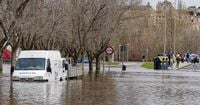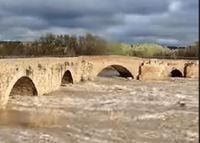The recent onslaught of Storm Martinho has resulted in severe consequences for Spain, particularly in Talavera de la Reina, where the iconic Roman bridge, known as the Puente Romano, partially collapsed due to extreme flooding of the Tagus River. This incident occurred during the night between March 21 and 22, 2025, as relentless rainfall from the storm inundated the region, dramatically raising water levels in the river.
Eyewitness accounts shared on social media revealed harrowing video footage of one of the bridge’s arches yielding to the powerful current. Local resident reactions were filled with shock and dismay as many recalled the historic importance of the structure. Thankfully, the bridge had been closed to vehicle traffic prior to its collapse, ensuring that no injuries occurred.
The Puente Romano, while often referred to as a Roman bridge, is largely a reconstruction from the 15th century, overseen by the monk Fray Pedro de los Molinos. It is not only a critical connection across the river but also a significant cultural symbol for the city. In recent years, it underwent restoration in 2002, preserving its historical attributes for future generations. This particular bridge holds a special place as one of Talavera de la Reina’s oldest and most recognizable landmarks.
During the collapse, the Tagus River was reported to be flowing at a staggering rate of over 1,000 cubic meters per second, equivalent to about 400 Olympic swimming pools worth of water per hour, as recorded by Spanish water authorities. Such high levels stemmed from the consistent, heavy rainfall triggered by Storm Martinho, which is now the fourth storm to hit Spain in just two weeks. This storm has unleashed havoc across various regions, leading to evacuations and extensive flood damage.
José Julián Gregorio, the mayor of Talavera, expressed his sorrow over the collapse in a social media post, declaring it "a terrible day for the history of our city". He emphasized the importance of the bridge, not only as a functional structure but as an embodiment of the city’s cultural and historical heritage. In response to the crisis, he has reached out to both the regional government of Castile-La Mancha and the national government of Spain for assistance in potentially rebuilding the bridge.
The collapse of the Puente Romano underscores a more significant concern about the extreme weather patterns currently affecting Spain. Storm Martinho has led to evacuations across various areas, with hundreds being removed from their homes as the storm has intensified rainfall and wind gusts. The situation continues to evolve, with authorities closely monitoring the rising water levels of the Tagus and other affected rivers.
In several towns surrounding Talavera, including Escalona, more than 100 residents were evacuated, and over 50 homes were inundated due to the overflow of the Alberche River. The immediate dangers have prompted swift action from local authorities, who have cordoned off impacted areas. They have urged both citizens and tourists to steer clear of these locations to ensure their safety amid ongoing risks of further collapses.
The cultural significance of the collapsed bridge cannot be overstated. Known for its artisanal ceramic production, Talavera de la Reina has a rich history reflected in vibrant, hand-painted pottery that dates back centuries. This tradition was recognized in 2019 when UNESCO designated it as an intangible cultural heritage. The bridge served as an important landmark for this identity, connecting local artisans to the surrounding community and visitors.
Efforts are now underway to assess the remaining structure of the bridge and determine the extent of the damage caused by the storm. Experts plan to conduct thorough inspections in the coming days, promising that any findings will be made available for both local authorities and the public.
The impact of Storm Martinho continues to resonate throughout Spain. With predictions of continued unstable weather, the people of Talavera de la Reina brace for the lingering aftermath of flooding. Despite the sun emerging on March 23, wind speeds are expected to subside, which may offer some relief. However, emergency services remain vigilant as the statistics from recent storms indicate the possibility of future incidents.
Although the immediate threat may pass, concerns regarding infrastructure and community safety remain paramount. Talavera de la Reina’s history and its cultural heritage hang in the balance, challenged by nature’s fury and the increasing intensity of climate events.
As the city reflects on its historical roots through the remnants of the bridge, it also faces the pressing need for recovery and resilience in the face of such unprecedented environmental challenges. The story of the Puente Romano, while marked by tragedy, may also become a tale of renewal as the community seeks to rebuild and restore its emblematic heritage.





